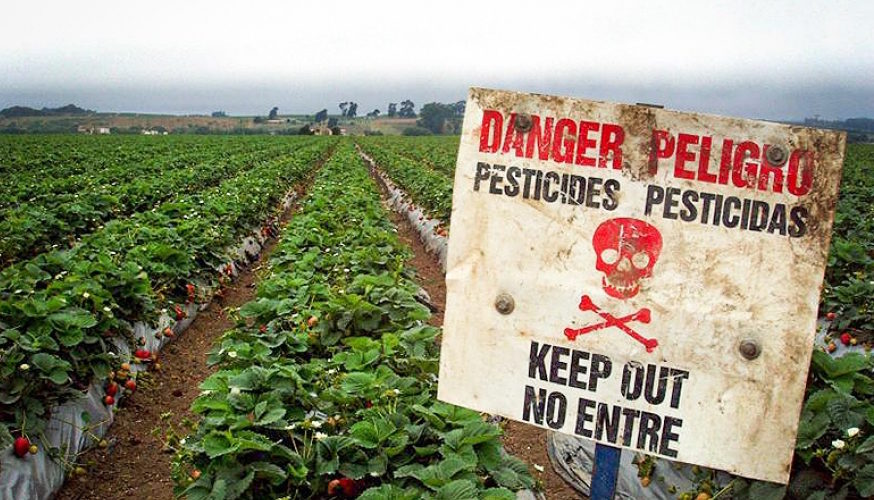By Glynn Wilson –
WASHINGTON, D.C. — Millions of children just in the United States have been diagnosed with some form of attention deficit disorder and/or hyperactivity disorder by psychiatrists and psychologists, and are often treated with pharmaceutical medication or behavioral therapy.
But what if these problems are not genetic or cultural psychological issues, but caused by chemicals children are exposed too in industrial society?
Farmers have been spraying chlorpyrifos on food crops such as strawberries, apples, citrus fruits, broccoli and corn since 1965. But studies now show this pesticide is inked to neurological damage in children, including reduced IQ, loss of working memory, and attention deficit disorders.
While the Trump administration fought to keep it in use, the Biden administration just announced it would be banned in food from now on after a court ruling forced the Environmental Protection Agency to provide proof of the chemical’s safety or regulate it out of existence.
This week the EPA issued a final ruling saying chlorpyrifos can no longer be used on the food that makes its way onto American dinner plates, a regulatory action intended to protect children and farmworkers, according to a press release from the agency.
In a statement announcing the decision, EPA Administrator Michael Regan called it “an overdue step to protect public health from the potentially dangerous consequences of this pesticide.”
“After the delays and denials of the prior administration, EPA will follow the science and put health and safety first,” Regan said.
Health, environment and labor organizations have been waging a campaign to revoke the use of chlorpyrifos for years. The EPA was considering a ban under the Obama administration, but under Trump, the agency concluded there wasn’t enough evidence showing the harmful effects of the chemicals on humans and kept it on the market.
That decision set off a series of legal challenges. Back in April, a federal appeals court ruled the decision was up to the EPA to produce indisputable proof that the pesticide is safe for children. If the agency failed to comply by Aug. 20, the judge said, then the food growers would be barred from using it.
In addition to use on farms, chlorpyrifos is one of several common household chemicals employed to try keeping ants, roaches, termites and mosquitos out of homes.
“It took far too long, but children will no longer be eating food tainted with a pesticide that causes intellectual learning disabilities,” said Patti Goldman, an attorney for Earthjustice, which represents health, environment and labor organizations behind the lawsuit. “Chlorpyrifos will finally be out of our fruits and vegetables.”
The Natural Resources Defense Council similarly cheered the EPA’s move, but cautions that the pesticide can still be used on other things, including cattle ear tags. The group wants a ban on other organophosphate pesticides, which are in the same chemical family as chlorpyrifos.
The new rule will take effect in six months.
In studies cited by the Centers for Disease Control and Prevention, children exposed to high chlorpyrifos are significantly more likely to experience Psychomotor Development Index and Mental Development Index delays, attention problems, attention-deficit/hyperactivity disorder problems, and pervasive developmental disorder problems.
The estimated number of children diagnosed with ADHD, according to a national 2016 parent survey, is 6.1 million, or 9.4 percent of all children in the U.S. This number includes 388,000 children between the ages of 2–5 years, another 2.4 million between the ages of 6 and 11, and 3.3 million from 12–17. Boys are more likely to be diagnosed with ADHD than girls (12.9% compared to 5.6%).
Many children with ADHD are also often diagnosed with other mental, emotional, or behavioral disorders.
About 5 in 10 children with ADHD had a behavior or conduct problem, according to surveys. About 3 in 10 children with ADHD suffered from anxiety. These same children often suffer as well from depression, autism spectrum disorder, and Tourette syndrome.
About 3 out of 4 children in the U.S. diagnosed with ADHD receive some form of treatment, 62 percent taking ADHD medication. Another 47 percent receive behavioral treatment
This has a major impact on the health care field. In studies from 2008–2011, children between the ages of 2 and 5 covered by Medicaid were twice as likely to receive clinical care for ADHD compared with similar-aged children covered by commercial employer-sponsored insurance. About 3 in 4 of these who had clinical care for ADHD recorded they received ADHD medication in their healthcare claims from 2008–2014. Fewer than half received any form of psychological services.
According to breaking news coverage of EPA’s announcement by The New York Times, chlorpyrifos is one of the most widely used pesticides commonly applied to corn, soybeans, apples, broccoli, asparagus and other produce.
The EPA decision follows an order in April by the Ninth Circuit Court of Appeals that directed the agency to halt the agricultural use of the chemical unless it could demonstrate its safety. Labor and environmental advocacy groups estimate that the decision will eliminate more than 90 percent of chlorpyrifos use in the country.
In an unusual move, the new chlorpyrifos policy will not be put in place via the standard regulatory process, under which the EPA first publishes a draft rule, then takes public comment before publishing a final rule. Rather, in compliance with the court order, which noted that the science linking chlorpyrifos to brain damage is over a decade old, the rule will be published in final form, without a draft or public comment period.
“The announcement is the latest in a series of moves by the Biden administration to re-create, strengthen or reinstate more than 100 environmental regulations,” gutted by the Trump administration, according to the Times.
The pesticide has been linked in studies to lower birth weights, reduced IQs and other developmental problems in children. Studies traced some of those health effects to prenatal exposure to the pesticide.
“Pesticides like chlorpyrifos haunt farm workers, especially parents and pregnant women,†said Elizabeth Strater, director of strategic campaigns for United Farm Workers of America, one of the groups on the petition. “They don’t hug their kids until they change clothes, they wash their laundry separately. When they miscarry, or when their children have birth defects or learning disabilities, they wonder if their work exposures harmed their children.â€
Several states — including California, Hawaii, New York and Maryland — have banned or restricted the use of chlorpyrifos, and the attorneys general of those states, as well as those of Washington, Vermont and Massachusetts, joined the petition.
The Obama administration began the process of revoking all uses of the pesticide in 2015 but, in 2020, the Trump administration ignored the recommendations of EPA scientists and kept chlorpyrifos on the market.
“It is very unusual,†Michal Freedhoff, the EPA assistant administrator for chemical safety and pollution prevention, said of the court’s directive. “It speaks to the impatience and the frustration that the courts and environmental groups and farmworkers have with the agency.â€
“The court basically said, ‘Enough is enough,’†Ms. Freedhoff said. “Either tell us that it’s safe, and show your work, and if you can’t, then revoke all tolerances.â€
The decision is expected to lead to criticism by the chemical industry and farm lobby, which worked closely with the Trump administration ahead of its decision to keep chlorpyrifos in use.
“The availability of pesticides, like chlorpyrifos, is relied upon by farmers to control a variety of insect pests and by public health officials who work to control deadly and debilitating pests like mosquitoes,†said Chris Novak, the chief executive of CropLife America, an agricultural chemical company, at the time of Trump’s decision.
Pesticide products that include chlorpyrifos include the brands Hatchet, manufactured by Dow AgroSciences; Eraser, manufactured by Integrated Agribusiness Professionals; and Govern, manufactured by Tenkoz.
Chlorpyrifos will still be permitted for nonfood uses such as treating golf courses, turf, utility poles and fence posts as well as in cockroach bait and ant treatments.
In a withering attack on the Trump EPA, Judge Jed S. Rakoff of the Ninth Circuit wrote on behalf of the court that, rather than ban the pesticide or impose restrictions, the agency “sought to evade, through one delaying tactic after another, its plain statutory duties.â€
According to additional coverage in The Washington Post, the regulation to curtail use of the potent insect-killing chemical on food overturns a 2017 decision by then-EPA Administrator Scott Pruitt to keep the pesticide on the market despite a recommendation by the agency’s scientists to restrict it, given its potential risks.
“For a half-century, chlorpyrifos has proved effective in keeping all sorts of pests off soybeans, almond trees, cauliflower and other crops. Farmers often deploy it when no other pesticide can do the job,” the newspaper reports. “But for the past decade, environmental, labor and public-health groups have clamored for phasing out the pesticide, which can lead to headaches or blurred vision when inhaled or ingested. Some studies of families in apartment buildings found that exposure during pregnancy led to memory loss and other cognitive issues in children.”
Claudia Angulo, a farmworker who came from Mexico to work the citrus and broccoli fields in California’s San Joaquin Valley, was pregnant when she was exposed to chlorpyrifos. She blames the pesticide for her son Isaac’s developmental delays, after the chemical showed up in tests on his hair.
“It’s affecting a lot of families. We’re all being affected, either with allergies or some with disabilities,†said Angulo, who is now part of a class-action lawsuit. “As a mother, I’m still struggling and won’t stop until this pesticide is not harming kids.â€
In one study, Impact of prenatal chlorpyrifos exposure on neurodevelopment in the first 3 years of life among inner-city children, scientists concluded:
“Results: Highly exposed children (chlorpyrifos levels of >6.17 pg/g plasma) scored, on average, 6.5 points lower on the Bayley Psychomotor Development Index and 3.3 points lower on the Bayley Mental Development Index at 3 years of age compared with those with lower levels of exposure. Children exposed to higher, compared with lower, chlorpyrifos levels were also significantly more likely to experience Psychomotor Development Index and Mental Development Index delays, attention problems, attention-deficit/hyperactivity disorder problems, and pervasive developmental disorder problems at 3 years of age.”
In addition to being banned in California, Hawaii, New York, Maryland, and Oregon, Canada and the European Union are already phasing out the insecticide on farms.
But federal regulators previously struck deals with chemical manufacturing companies to limit the use of chlorpyrifos for killing termites and several pests in homes, treating golf courses, and for growing cotton. The EPA will make a decision on whether to continue to allow for those and other nonfood uses by the end of next year.
According to the agency, the U.S. has a safe and abundant food supply, and children and others should continue to eat a variety of foods, as recommended by the federal government and nutritional experts. Washing and scrubbing fresh fruits and vegetables will help remove traces of bacteria, chemicals and dirt from the surface. Very small amounts of pesticides that may remain in or on fruits, vegetables, grains, and other foods decrease considerably as crops are harvested, transported, exposed to light, washed, prepared and cooked.














